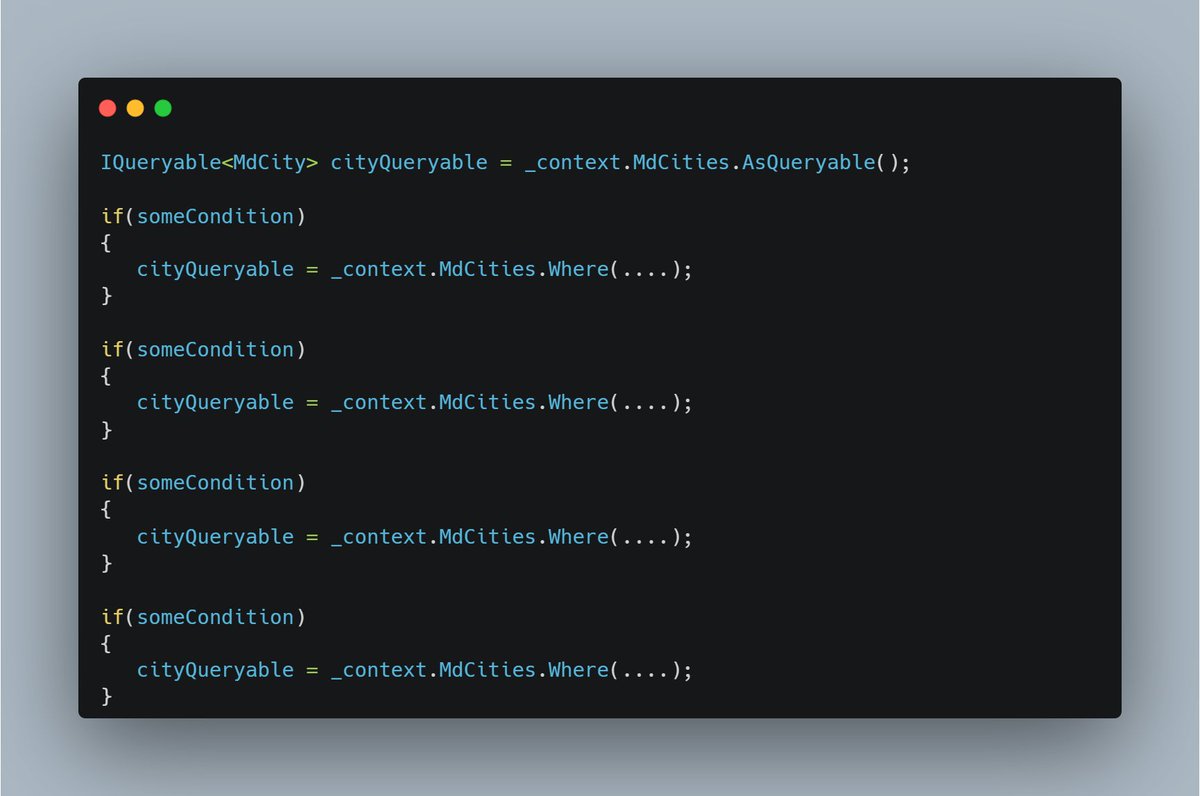
💡 7 Tips to write better LINQ Queries
𝐔𝐬𝐞 𝐨𝐟 𝐀𝐬𝐍𝐨𝐓𝐫𝐚𝐜𝐤𝐢𝐧𝐠 : For read only queries e.g. (GetAll,GetById etc.) use AsNoTracking , when we use it entities are not tracked for change so it brings data more speedily. #dotnet
See thread 🧵🔽
𝐔𝐬𝐞 𝐨𝐟 𝐀𝐬𝐍𝐨𝐓𝐫𝐚𝐜𝐤𝐢𝐧𝐠 : For read only queries e.g. (GetAll,GetById etc.) use AsNoTracking , when we use it entities are not tracked for change so it brings data more speedily. #dotnet
See thread 🧵🔽

𝐈𝐧𝐜𝐥𝐮𝐝𝐞 𝐧𝐞𝐜𝐞𝐬𝐬𝐚𝐫𝐲 𝐄𝐧𝐭𝐢𝐭𝐢𝐞𝐬 𝐚𝐧𝐝 𝐂𝐨𝐥𝐮𝐦𝐧𝐬 : While retrieving data from multiple table make sure to include only necessary tables and columns Use eager loading only when it is necessary.
#dotnet
#dotnet
𝐅𝐨𝐫 𝐥𝐚𝐫𝐠𝐞 𝐝𝐚𝐭𝐚 𝐮𝐬𝐞 𝐒𝐤𝐢𝐩 𝐚𝐧𝐝 𝐓𝐚𝐤𝐞 : Use skip and take to retrieve data from table for large collections because if we try to bring all data in single try it can take time that will give bad user experience takes next values.
#dotnet
#dotnet

𝐔𝐬𝐞 𝐚𝐬𝐲𝐧𝐜 𝐦𝐞𝐭𝐡𝐨𝐝𝐬 : For better user experience use async methods e.g. FirstOrDefaultAsync , SingleOrDefaultAsync and ToListAsync.
#dotnet
#dotnet

𝐑𝐞𝐝𝐮𝐜𝐞 𝐓𝐫𝐢𝐩𝐬 𝐭𝐨 𝐃𝐚𝐭𝐚𝐛𝐚𝐬𝐞 : Use bulk operations available for SAVE/DELETE operations instead of iterating one by one it will reduce trips to database. After that only write one line await _context.SaveChangesAsync(); to reflect changes over database.
#dotnet
#dotnet

𝐔𝐬𝐞 𝐓𝐫𝐲𝐆𝐞𝐭𝐍𝐨𝐧𝐄𝐧𝐮𝐦𝐞𝐫𝐚𝐭𝐞𝐝𝐂𝐨𝐮𝐧𝐭 : For large of data we use pagination and it is displayed on basis of total records. Use TryGetNonEnumeratedCount instead of count it attempts to determine the number of elements in a sequence without forcing an enumeration 

𝐔𝐬𝐞 𝐈𝐐𝐮𝐞𝐫𝐲𝐚𝐛𝐥𝐞 : For long and condition based filters use IQueryable,it executes queries on the server side.After all conditions we can use ToList to fetch data it makes query faster as we are first creating complete query and then we are bringing the data
#dotnet
#dotnet

📧 If you like it join family of 550+ Software Engineers via my Newsletter : lnkd.in/dNHxJGRG
#dotnet
#dotnet
• • •
Missing some Tweet in this thread? You can try to
force a refresh






